We’ve gathered our favorite festive recipes from onX staff, partners, and ambassadors. Which one will grace your table this Thanksgiving?
It’s that time of year again. During the hustle of a busy season, we always look forward to a few days to relax, celebrate, and just make merry with friends and family. A large part of why we hunt is to fill the freezer, and the Thanksgiving holiday gives us an annual excuse to showcase our cooking skills with the meat we’ve put so much effort into harvesting.
We’ve gathered a few favorite recipes from in-house onX staff members, ambassadors, and partners. From an elegant Roast Pheasant with Root Vegetables and Red Currant and a Port and Red Wine Sauce from Steven Rinella’s The MeatEater Fish and Game Cookbook, to onX Customer Success Technician Sarah Allen’s easy Venison Meatballs, here’s a taste of what will be gracing our Thanksgiving tables this year.
Venison Meatballs
Sarah Allen, onX Customer Success Technician
Ingredients:
- 1 medium onion, finely chopped
- 1/2 cup uncooked instant rice
- 1 teaspoon salt
- 1/4 teaspoon pepper
- 1 pound ground venison
- 3/4 cup water
- 1/3 cup packed brown sugar
- 1/3 cup ketchup
- 1/3 cup condensed tomato soup, undiluted
- 1 tablespoon ground mustard
- 2 teaspoons paprika (optional)
Directions:
Step 1: In a bowl, combine the first 4 ingredients, then crumble venison over mixture. Mix well and form 1-1/2-inch meatballs. Place in an 8-inch baking pan. Combine the remaining ingredients, then pour over the meatballs.
Step 2: Bake uncovered at 375°F for 35-45 minutes.
From Taste of Home, Hunting and Fishing Cookbook.
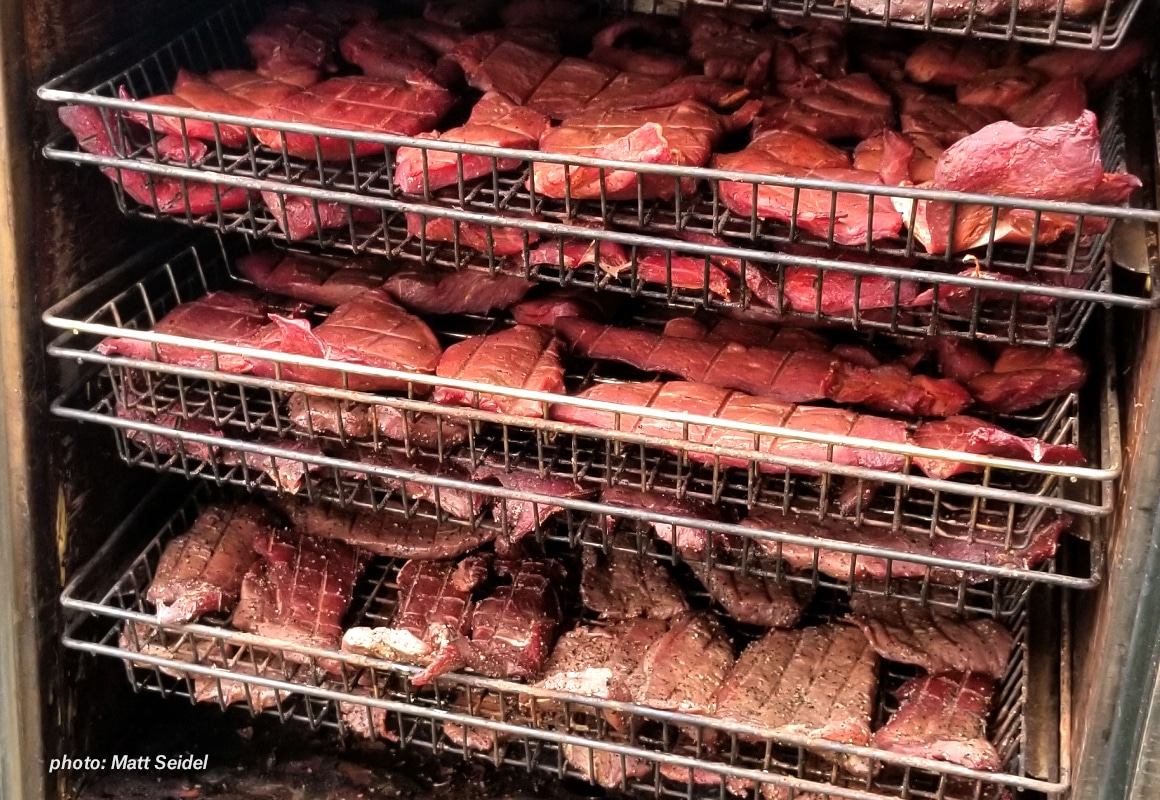
Sous Vide Steak
Steven Drake, onX Ambassador
My culinary skills are lacking. Traveling a majority of the year means that when I am home, I use the bare minimum to prepare wild game. This typically means pan-fried steaks with a can of beans, which isn’t bad but it could always be better.
Fast forward to one of the most popular fads in cooking, the Sous Vide. My roommate who lives a similar bachelor lifestyle picked one up based on its claim of simplicity and being able to make a five-star steak in one hour. (We picked up the Anova Precision Cooker.) Here’s the simple step-by-step process for cooking a mean steak:
Ingredients:
- Steak of your choice: deer, elk, antelope, or other
- Salt and pepper
Directions:
Step 1: Thaw, then lightly marinate steak with salt and pepper in a 1-gallon ZipLoc bag.
Step 2: Fill a large pot with water and attach the Sous Vide. Immerse steak, while still in ZipLock, into the water.
Step 3: Select the steak setting on your Sous Vide and press start.
Step 4: 45 minutes later, remove the steak and sear it in a cast iron pan for 20 seconds per side. This adds flavor and seals in the juices.
Step 5: Eat and prepare to be the cook at all future friend and family gatherings.
We’ve prepared deer, elk, antelope, and even all three at the same time in the same ZipLoc with outstanding results. The Sous Vide is a fad for a reason. And no, I’m not sponsored or endorsed by the Anova Precision Cooker in any way… it’s just that good.
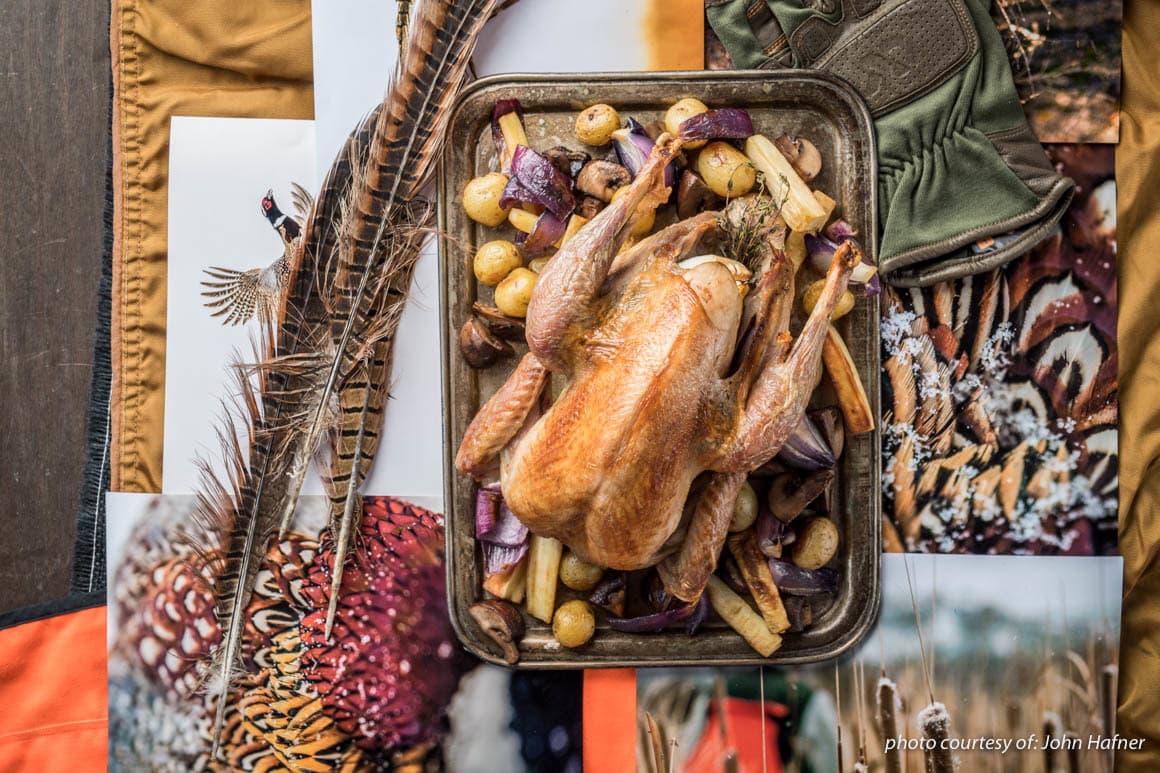
Roast Pheasant with Root Vegetables and Red Currant, Port, and Red Wine Sauce
From Steven Rinella’s The MeatEater Fish and Game Cookbook
Ingredients:
Pheasants
- 2 young pheasants
- 1 recipe Enriched Brine (or other brine)
- 2 small lemon wedges
- 2 small onion wedges (can be taken from roasted veggies below)
- 4 sprigs fresh thyme
- 1 tablespoon olive oil or 1 tablespoon softened butter
- Kosher salt
- Freshly ground black pepper
- 1 cup low-sodium chicken broth
Vegetables
- 8 ounces cremini mushrooms, halves, or wild mushrooms, cut into large pieces
- 8 ounces micro potatoes, scrubbed clean and patted dry
- 2 parsnips, cut into 1-1/2-to-2-inch pieces, fatter ends quartered
- 1 red onion, cut into wedges with the core end intact
- ¼ cup extra virgin olive oil
- Kosher salt
- Freshly ground black pepper
Sauce
- 1 tablespoon salted butter
- 3 sprigs fresh thyme
- 1 clove garlic, crushed
- 1 shallot, halved
- ½ cup tawny port
- ½ red wine
- ¾ cup low-sodium chicken broth
- 2 tablespoons red currant or lingonberry preserves or jelly
- Kosher salt and freshly ground black pepper
Directions:
For the Pheasants: Add the pheasants to the brine and brine for 4 to 8 hours. Remove the pheasants from the brine and pat dry. Bring the birds to room temperature for 30 minutes. Preheat the oven to 450℉.
Stuff each pheasant with a lemon wedge, onion wedge, and 2 thyme sprigs. Rub oil or butter all over the birds, then sprinkle with salt and pepper. Place the pheasants in a large, heavy oven-safe skillet.
For the Vegetables: Arrange the mushrooms, potatoes, parsnips, and onion on a baking sheet and drizzle all over with the oil. Sprinkle generously with salt and pepper. Gently toss the vegetables, then spread out in a single layer.
Roast the pheasant and vegetables for 15 minutes.
Add the stock to the pheasant pan. Reduce the heat to 350℉ and roast until the juices run clear and an instant-read thermometer inserted into the thickest part of the thigh reads 155℉, about 20 more minutes. Continue to roast the vegetables until tender. Remove from the over and tent with foil. Remove the pheasants from the skillet and transfer to a platter. Tent loosely with foil.
For the Sauce: Place a medium skillet over medium-high heat. Add the butter and any juices accumulated from the roasting pan, the thyme, garlic, and shallot to the skillet and cook, stirring, for 3 minutes. Add the port and red wine, scraping up the browned bits from the bottom of the pan, and cook until the liquid is reduced by half, about 10 minutes. Add the stock to the pan and continue to reduce until thickened, 8 to 10 more minutes. Discard the thyme, garlic, and shallot. Stir in the preserves and season with salt and pepper. (This sauce can be used for any roasted meat recipe.)
Carve the pheasants and serve with the vegetables and sauce. Serves 4.
Summer Sausage
Rachael Caldwell, Brand Team Producer
Most summer sausage recipes are similar, but we’ve learned a few little tricks along the way to ensure our summer sausage has the right consistency, flavor, and texture. Here are the basic steps, along with a few tips:
First, give yourself a lot of time. Even after you’ve got the sausage ground and mixed, the smoking alone will take around 12 hours. Low and slow is the ticket. Second, be sure to have all you need on hand before you start grinding the meat, including your preferred seasoning brand (we love Hi-Country), your casings, and pork shoulder to add in.
Ingredients:
- Elk (or game meat of your choice)
- Pork shoulder (you’ll need about a 45% pork to 55% game meat ratio)
- Cheese, chopped into 1/8 inch squares (we like to use a 16-oz. block of sharp cheddar and an 8-oz. block of pepper jack)
- Your favorite summer sausage seasoning brand and casings
Prep:
Before you begin grinding, get out your casings and soak them in warm water for at least 30 minutes.
Grinding:
While the casings are soaking, start grinding your meat. Cut the game meat and pork shoulder into chunks, keeping it as cold as possible throughout the process so your fat doesn’t melt and grinding is easier. On the first grind, use a coarse grind plate and mix in the pork shoulder as evenly as possible with the game meat.
After the first grind, add your spice packet and cure/water mixture based on your seasoning brand’s instructions. Mix thoroughly to ensure the bind of the sausage. Send this mixture through the grinder a second time with a 3/16″ sausage plate. Once grinding is complete, mix cheese squares in by hand until well distributed.
Stuffing:
Set up your stuffer with the largest horn that still fits the casings. Stuff meat tightly into each casing, leaving some casing at the end to twist and tie off tightly so there’s no extra space between the casing and the sausage. Refrigerate overnight, then allow sausages to come back to room temperature before cooking them the following day. If incorporating cheese, a hand stuffer will be necessary.
Smoking:*
Set your smoker to 135℉. If you have a large enough smoker, you can either hang your sausages from the smoke rods on top or lay them on racks. Just be sure to keep them at least two inches apart and away from the walls of the smoker.
Insert your thermometer into the end of one of your sausages (this is easy to do if you loosen the string at one end). Cook until internal temp of sausage reaches 80-85℉.
Apply smoke and reset smoker temp to 160℉. If possible, add a shallow tray with water to the bottom of your smoker to keep the casing moist. If sausages are lying flat, roll them to the opposite side and rotate rack levels to cook evenly. Cook to an internal temp of 140-145℉.
Finally, set your smoker temp to 180℉ and finish cooking to a final internal temp of 152℉. Be patient and expect this process to take a total cook time of 12 or more hours.
Once sausages have reached 152℉, remove and soak in very cold water for 10 minutes to set the fat. Setting the fat produces a visually appealing sausage as well as sets a consistent texture. Wipe down with paper towel and let air dry on cooling racks or in the refrigerator. Store as normal; eat within a week if refrigerating.
*Note: We have also cooked some of our summer sausages in the oven (when we ran out of space in the smoker). You can also start them in the smoker and finish in the oven if needed. To cook in the oven, follow the same steps as above, except with the following temps: Preheat oven to 170℉; cook to 145℉, adding a tray of water for moisture if possible; rotate sausages and raise oven temp to 200℉; cook to internal temp of 152℉. Remove and soak in cold water for 10 minutes.
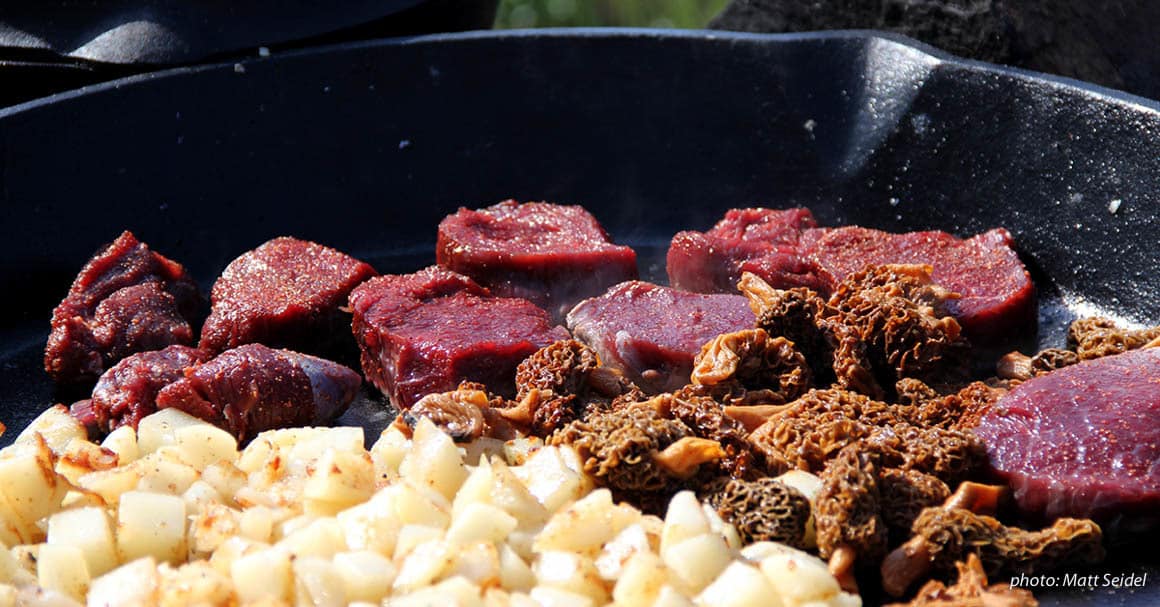
Swiss Steak – Venison or Elk
Rob Lund, onX Senior Software Engineer
Ingredients:
- 2 tablespoons flour
- 1/4 teaspoon salt
- 1/4 teaspoon pepper
- 1-1/2 – 2 lbs. venison round or sirloin steaks (4 or 5 pieces)
- 1 tablespoon shortening or butter
- 1 8-ounce can of whole tomatoes
- 1 medium onion – chopped
- 1/2 green pepper – chopped
Directions:
Step 1: In a bowl, mix flour, salt and pepper. Sprinkle on the meat and pound in. Flip and pound in remaining mixture.
Step 2: Heat shortening in a skillet. Brown meat over medium heat (about 10 minutes). Add tomatoes (with liquid), onion and pepper. Reduce heat and cover. Simmer until meat is tender, about 45 minutes.
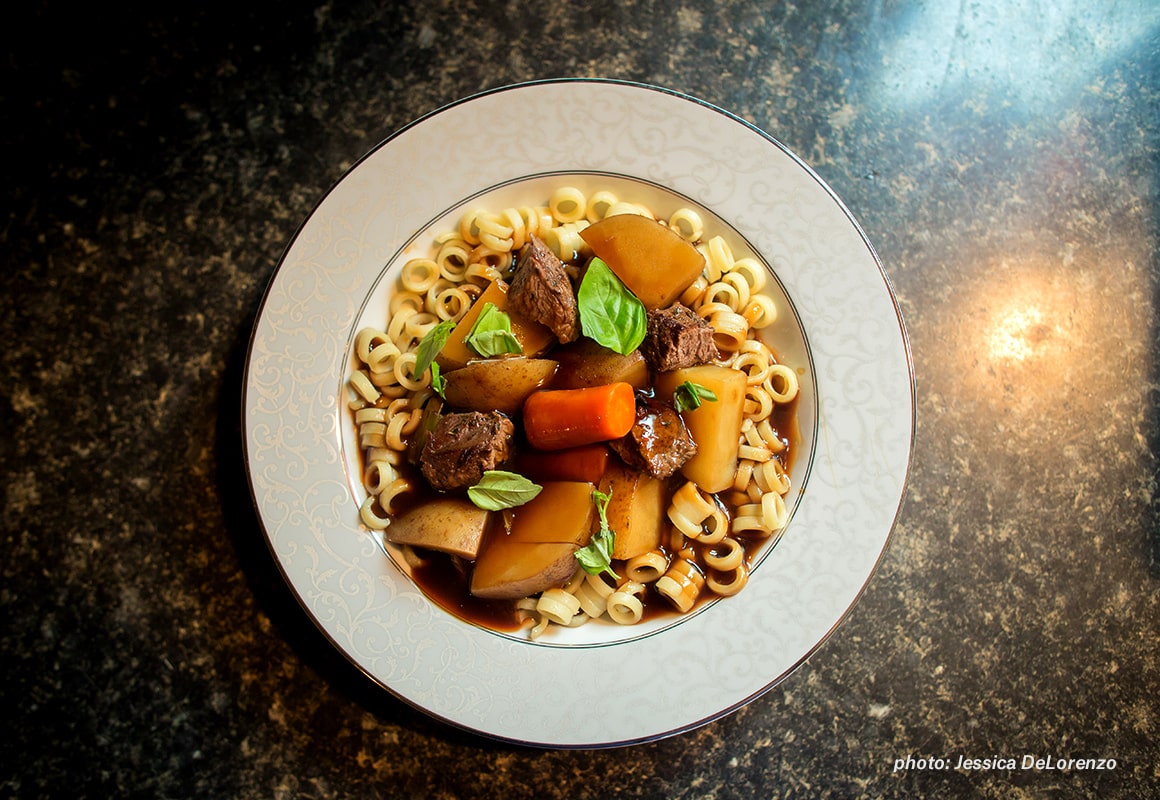
Wild Game Stew
Jessica DeLorenzo, onX Ambassador
Ingredients:
- 2 tablespoons canola oil
- 2 pounds of stew meat (works with pronghorn, wild turkey, venison, elk, etc.)
- 2 large onions chopped
- 3 tablespoons crushed garlic
- 1 tablespoon Worcestershire sauce
- 2 bay leaves
- 2 teaspoons dried oregano
- 1 tablespoon salt
- 1 teaspoon pepper
- 3 cups water
- 7 potatoes, peeled and quartered
- 1 pound carrots, cut into 1-inch pieces
- 1/4 cup flour
- 1/4 cup water
- Browning sauce
- Handful of chopped fresh basil
- 1 pound of your favorite pasta shape
Directions:
Step 1: Trim any undesirables from the meat. Season with salt and pepper. Heat oil in a Dutch oven, (I use a cast iron skillet and transfer to the dutch oven after browning). Brown meat. Add onions, garlic, Worcestershire sauce, bay leaves, oregano, salt, pepper and water. Simmer, covered, 1-1/2 to 2 hours or until meat is tender. Add potatoes and carrots. Continue to cook until vegetables are tender, about 30-45 minutes.
Step 2: Mix flour and cold water; stir into stew. Meanwhile, boil pasta according to directions. Cook and stir until thickened and bubbly. Add browning sauce if desired. Remove bay leaf. Serve over pasta. Garnish with basil.
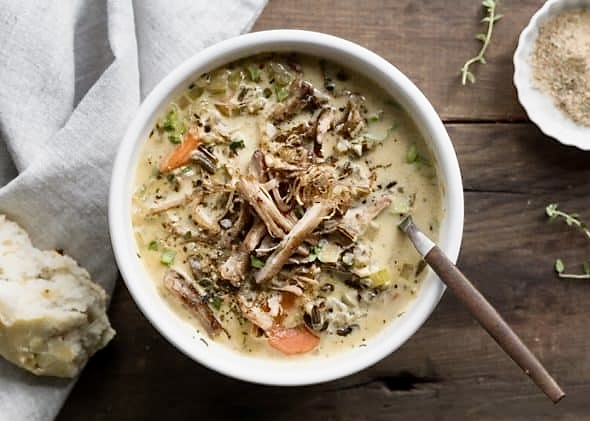
Turkey and Wild Rice Soup
Danielle Prewett, MeatEater Wild Foods Contributing Editor
From Danielle Prewett: “As an upland hunter, my favorite Thanksgiving tradition is to roast a couple of whole pheasants. I save meat from the thighs and shred it to create a delicious pheasant and wild rice soup. Whether you have pheasant or turkey on your table this year, you’ll be hard-pressed to find a better way to enjoy those leftovers. Pan-frying the shredded meat in butter just before serving is what makes this recipe extra special. This critical step creates rich flavors and a crunchy texture to compliment the creaminess of the soup.”
Ingredients:
- 3 tablespoons butter, divided
- 1 onion, diced
- 2 carrots, roughly chopped
- 4 cloves garlic, minced
- 2 tablespoons all-purpose flour
- 2 tablespoons lemon juice or white vinegar
- 2-1/2 quarts unsalted chicken stock
- 3 tablespoons Gnome on the Range Mushroom Blend
- 2 tablespoons fresh thyme leaves
- 1 cup wild rice, rinsed
- 1-1/2 cups heavy cream
- 4 cups shredded turkey or pheasant meat, cooked
- Celery leaves to garnish
Directions:
Step 1: Preheat a heavy pot over medium-high heat. Once hot, drop in 1 tablespoon of butter. When the butter foams, add the onions and saute until soft. Add the carrots and celery, then cook for a few minutes before adding the garlic. Cook for one minute or until fragrant.
Step 2: Sprinkle in the flour and stir to combine. Squeeze in lemon juice and add the chicken stock, scraping up any bits of fond at the bottom of the pot.
Step 3: Season with Gnome on the Range Mushroom Blend and fresh thyme. Stir in the wild rice.
Step 4: Reduce the heat to medium-low and let the pot simmer for 30 minutes. The rice should almost be cooked through, and the liquid should be slightly reduced.
Step 5: Pour in the heavy cream and cook for another 15-20 minutes or until the rice is tender. Taste and adjust with extra seasoning if needed.
Step 6: When the soup is almost ready to serve, heat a separate frying pan over medium-high heat. Drop in the remaining two tablespoons of butter and fry the shredded turkey for a couple of minutes on each side. Don’t overcrowd the pan—work in batches if necessary to ensure that the meat is brown and crispy.
Step 7: Serve the soup with a heap of the fried turkey on top and garnish with chopped celery leaves.
What’s your favorite tried-and-true holiday recipe? Find us on Facebook or Instagram and leave a note in the comments.
Loved this recipe? See our latest on How to Make Pemmican.